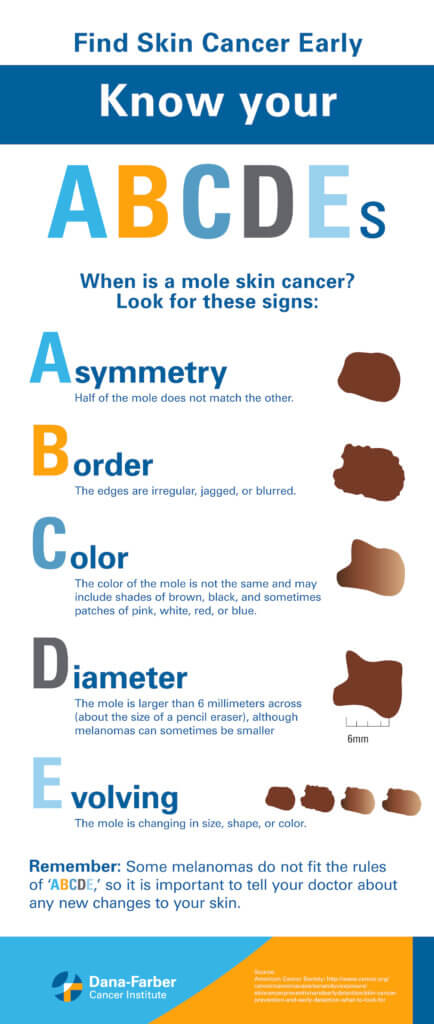Atypical moles are irregular moles that can appear anywhere on the body. They are more commonly found on people with fair skin, as well as those with many freckles and moles on the body (more than 50).
What do atypical moles look like?
In order to spot atypical moles or something more serious, dermatologists recommend performing regular self-exams and following the ABCDEs:
- A – Asymmetry, or when one half of the mark appears different than the other.
- B – Border, when the mark has an irregular, scalloped, or poorly defined border.
- C – Color, if the mark is varied from one area to the other or black in color. Color variation may have any combination of shades of tan, brown, black, or be white, red, or blue.
- D – Diameter. Melanomas are usually bigger than 6mm, or the size of a pencil eraser. In some cases, they can appear smaller.
- E – Evolving, when a mole or mark looks different over time. It is getting larger, changing colors, or new symptoms of bleeding, itching, or hurting.
Another important sign is the “ugly duckling” sign. When one lesion on the body looks different from others on the body. For example, if you have one pink mole and your other ones are brown. The pink mole would be the ugly duckling.
If a mole has one or more of these characteristics, it should be brought to the attention of a dermatologist.

Is an atypical mole cancerous?
While atypical moles are not cancerous, the presence of one can indicate a higher risk of melanoma, a form of skin cancer that forms in the lower part of the epidermis (outer) layer of the skin. Melanoma is much less common than the other types of skin cancer, but is often the severest form.
Is it normal to have an atypical mole?
Yes, it is fairly normal. About 1 in 10 Americans have some sort of atypical mole.
Should an atypical mole be removed?
If a doctor does decide that it is beneficial to have an atypical mole removed, usually when it shows signs of becoming cancerous, a procedure called an elliptical excision is performed. This surgery involves removing the atypical mole and some of the surrounding skin as a preventive measure in case any existing cancer in the area spread outward. After the tissue is removed, a pathologist will test it to see if the cells are cancerous.
If you have a family history of skin cancer and atypical moles, it is recommended that you speak to your dermatologist about tracking these moles and the next steps you should take.
How often should I get my skin checked?
If you have many moles (more than 50), atypical moles, or a family history of melanoma, you should have an annual evaluation by a dermatologist.
If you are a person who has already had skin cancer, it is important to regularly get your skin checked by a doctor. Your doctor can help you determine how many visits you need each year.
An important thing to remember is to keep a keen understanding of your own skin. Skin self-exams can help you easily detect if something new or suspicious arises.
What are the risk factors of skin cancer?
Having one or more risk factors for any form of skin cancer does not mean you will get skin cancer, just as not having them doesn’t mean you will not get skin cancer. Risk factors mean that your likelihood of getting skin cancer increases.
Talk to your doctor about skin cancer screening if you have any of these risk factors:
- Long periodical exposure to natural or artificial sunlight
- Fair complexion, including:
- Freckles
- Blue or green eyes
- Skin that sunburns easily
- Blonde or red hair
- A history of sunburns
- A personal or family history of skin cancer
- Having certain changes in the genes or hereditary syndromes, such as basal cell nevus syndrome, that are linked to skin cancer
- Having skin inflammation that has lasted for long periods of time
- Having a weakened immune system
- Being exposed to arsenic
- Past treatment with radiation
